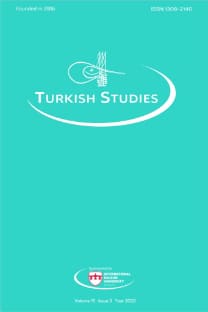ONLİNE TÜKETİCİ DAVRANIŞINI ETKİLEYEN FAKTÖRLERİN BİRLEŞTİRİLMİŞ TEKNOLOJİ KABUL VE KULLANIM TEORİSİ KULLANARAK İNCELENMESİ
EXAMINATION OF FACTORS AFFECTING ONLINE CONSUMER BEHAVIOR FROM THE PERSPECTIVE OF THE UNIFIED THEORY OF ACCEPTANCE AND USE OF TECHNOLOGY
___
- Al-Gahtani, S.S., G.S. Hubona, J. Wang (2007) “Information Technology (IT) in Saudi Arabia: Culture and the Acceptance and use of IT”, Information & Management, 44, 681-691.
- Bagozzi, R. P., Gopinath, M., and Nyer, P. U. (1999) “The role of emotions in marketing”, Journal of Academy of Marketing Science, 27(2), pp. 184-206.
- Barsh, J. Crawford, B., and Grosso, C (2000) “How e-tailing can rise from the ashes”, McKinsey Quarterly, 3, pp. 98-110.
- Cheung, C. M. K., Chan, G. W. W., and Limayem, M. (2005) “A critical review of online consumer behavior: Empirical research”, Journal of Electronic Commerce in Organizations, 3(4), pp. 1- 19.
- Davis, F.D., R.P. Bagozzi, P.R. Warshaw (1992) “Extrinsic and Intrinsic Motivation to Use Computers in the Workplace”, Journal of Applied Social Psychology, 12(4), 1111-1132.
- Hu, L., & Bentler, P. M. (1999). Cutoff criteria for fit indexes in covariance structure analysis: Conventional criteria versus new alternatives. Structural Equation Modeling, 6, 1-55.
- Im, I., S. Hong, M.S. Kang (2011) "An International Comparison of Technology Adoption Testing the BTKKT Model", Information & Management, 48(1), (January), 1-8.
- Jöreskog, K., D. Sörbom (2001) LISREL 8: User’s Reference Guide, Chicago: Scientific Software International Inc.
- Kijsanayotin, B., S. Pannarunothai, S.M. Speedie(2009) “Factors Influencing Health Information Technology Adoption in Thailand’s Community Health Centers: Applying the BTKKT model”, International Journal of Medical Informatics, 78, 404-416.
- Kline, R. B. (2011). Principles and practice of structural equation modeling. New York, NY: Guilford
- Li, N. and Zhang, P. (2002) “Consumer online shopping attitudes and behavior: An assessment of research”, Eighth Americas Conference on Information Systems, 2002.
- Lin, C.P., Anol, B. (2008) “Learning Online Social Support: An Investigation of Network Information Technology Based on BTKKT”, Cyberpsychology & Behavior, 11(3), 268-272.
- Pavlou, P. A. (2003) “Consumer acceptance of electronic commerce: Integrating trust and risk with the technology acceptance model”, International Journal of Electronic Commerce, 7(3), pp. 69- 103.
- Şimşek, Ö. F. (2007). Yapısal Eşitlik Modellemesine Giriş Temel İlkeler ve LISREL Uygulamaları. Ankara: Ekinox.
- Venkatesh, V., M.G. Morris, G.B. Davis, (2003) “User Acceptance of Information Technology: Toward a Unified View”, MIS Quarterly, 27(3), 425-478.
- Wang, H.I., H.L. Yang (2005) “The Role of Personality Traits in BTKKT Model Under Online Stocking”, Contemporary Management Research, 1(1), 69-82.
- Wang, Y.S., Y.W. Shih (2009) “Why do People use Information kiosks? A validation of the Unified Theory of Acceptance and Use of Technology”, Government Information Quarterly, 26, 158- 165.
- Zhou, L., Dai, L., and Zhang, D. (2007) “Online shopping acceptance model - A critical survey of consumer factors in online shopping”, Journal of Electronic Commerce Research, 8(1), pp. 41- 62.
- ISSN: 1308-2140
- Yayın Aralığı: 4
- Başlangıç: 2006
- Yayıncı: Mehmet Dursun Erdem
PAZARLAMA KARMASI ELEMANLARI VE GÜVEN
GENÇ TÜKETİCİLER İÇİN KOT PANTOLON NİTELİKLERİNİN ÖNEMİ
ÖĞRENCİ HARCAMALARININ İLİN EKONOMİSİNE KATKILARININ MUNZUR ÜNİVERSİTESİ YÖNÜNDEN DEĞERLENDİRMESİ
MICHEL FOUCAULT’DA ÖZNENİN TARİHSEL ONTOLOJİSİ VE İKTİDAR İLİŞKİLERİ ANALİZİ
THE RELATIONSHIP BETWEEN CORPORATE SOCIAL RESPONSIBILITY AND CORPORATE REPUTATION
FETULLAH BATTAL, SİNAN YAZICI, ERTUĞRUL ÇINAR, ŞENOL KILIÇASLAN
EVRENSELCİLİKTEN VAZGEÇİŞ: JOHN RAWLS’UN İNSAN HAKLARI KAVRAYIŞININ DÖNÜŞÜMÜ
KURUMSAL SOSYAL SORUMLULUK VE KURUMSAL İTİBAR İLİŞKİSİ
Fetullah BATTAL, Ertuğrul ÇINAR, Sinan YAZICI, Şenol KILIÇASLAN
ÖRGÜTSEL SOSYALLEŞMENİN ÖRGÜTSEL ÖZDEŞLEŞME ÜZERİNE ETKİSİ: BANKACILIK SEKTÖRÜNDE BİR ARAŞTIRMA
